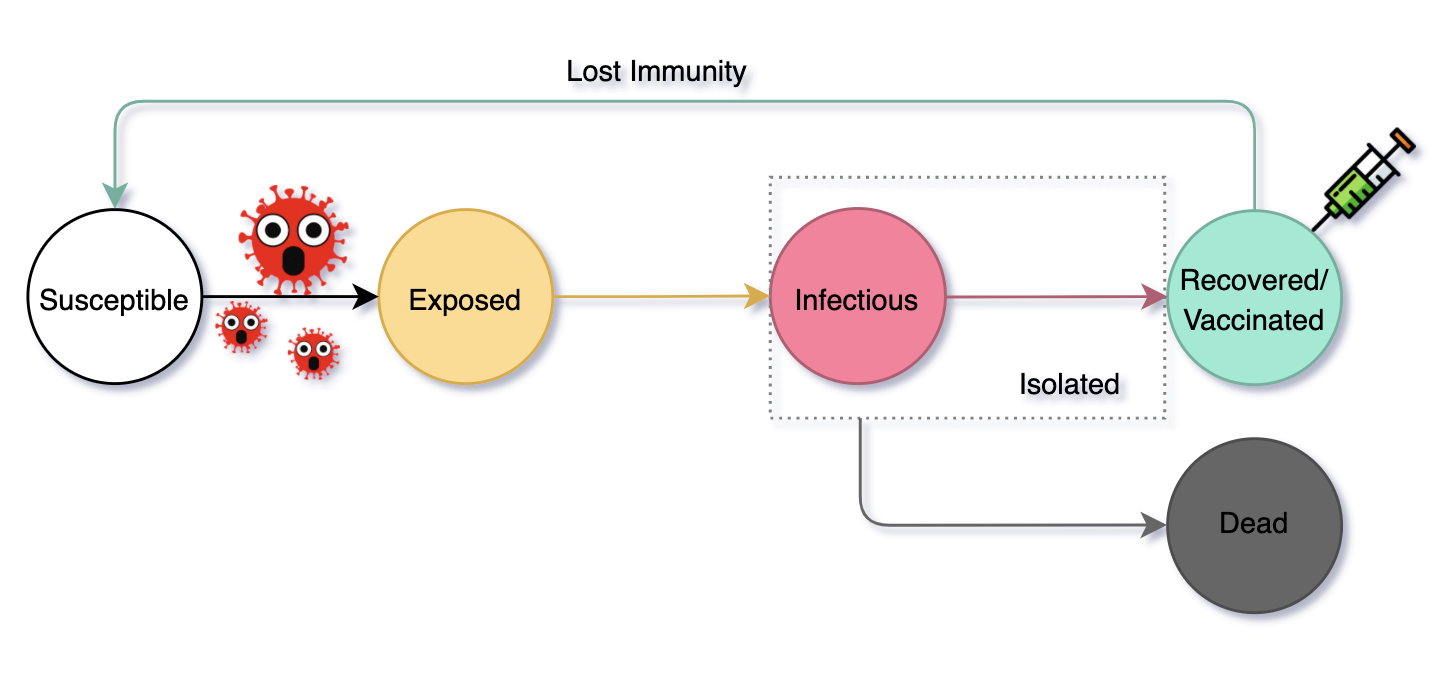COVID-19 outbreak modelling and simulation with respect to the longevity of antibody and vaccination strategy
This project is designed to simulate virtual virus spreading scenarios to address concerns about COVID-19 in early 2020.
Researchers and scientists across the world have been developing vaccines against the novel coronavirus (COVID-19) amid the unprecedented pandemic since late 2019. As of August 2020, some candidate vaccines are in phase 3 clinical trials - tests for efficacy and safety on human beings. However, some scientists raise concern over how long the immunity to COVID19 may last. According to a recent study [1], patients start losing existing antibody responses within months which is a considerably short period compared to other viruses such as chickenpox and measles - their immunity could last for more than half-century [2]. If it is true, the pattern of virus transmission may significantly vary depending on vaccination strategy and duration of antibody responses. I implemented an agent-based model in NetLogo to simulate virtual scenarios based on a modified SEIR model and address the following questions.
- How does the epidemic curve change with respect to vaccinated populations under the two different conditions (short and long longevity of immunity)?
- How could we prevent and control onset outbreaks?
-
Initial parameters are based on previous researches to represent the characteristics of the specific pathogen COVID-19 [3-5].
-
Transmission process is modified from the basic SEIR model to reflect asymptomatic infected patients. (a) Initially, people have one of the disease phases (susceptible, exposed and immune through vaccination); (b) Once a susceptible person is exposed by the virus,(s)he is infectious with mild symptoms; (c) After an asymptomatic period, I assume the person is officially diagnosed with the virus and isolated immediately. The isolation effectiveness is 100 % (no further virus spreading); (d) The person dies or recovers with immunity in an isolation time. (e) After a valid time of immunity, people can be reinfected.
Either download NetLogo or use web version NetLogo at https://ccl.northwestern.edu/netlogo/. For a brief look, I suggest to use the web version NetLogo by uploading covid19 simulator.nlogo. Compatible with NetLogo 6.2.2.
In this project, I exported the results from NetLogo in R. Firstly, run Data load.R to read /results.csv (path may differ as yours). Then, run Result analysis.R to analyse and visualise the loaded data.
R studio is available at https://www.rstudio.com/products/rstudio/download/.
[1] Seow, J. et al. Longitudinal evaluation and decline of antibody responses in SARS-CoV-2 infection. medRxiv. 2020; DOI:10.1101/2020.07.09.20148429
[2] Alice Antia, et al. Heterogeneity and longevity of antibody memory to viruses and vaccines. PLoS Biology. 2018; DOI:10.1371/journal.pbio.2006601
[3]Backer JA, Klinkenberg D, Wallinga J. The incubation period of 2019-nCoV infections among travellers from Wuhan, China. medRxiv. 2020; (published online Jan 28.) (preprint). DOI: 10.1101/2020.01.27.20018986
[4] WHO Director-General's opening remarks at the media briefing on COVID-19 - 24 February 2020
[5] WHO Director-General's opening remarks at the media briefing on COVID-19 - 3 March 2020
